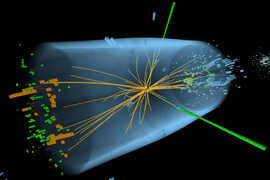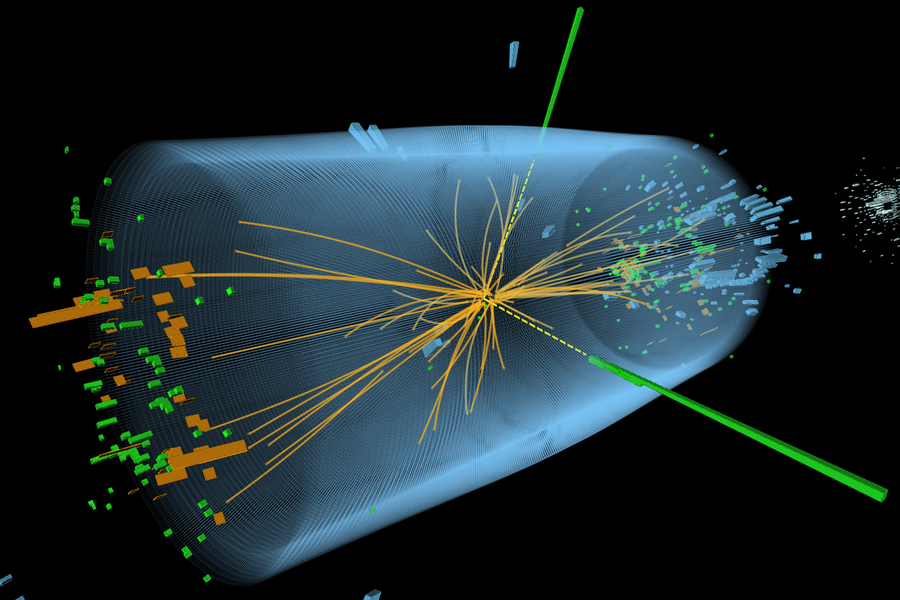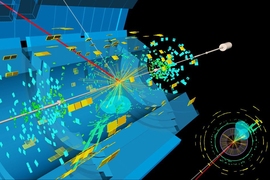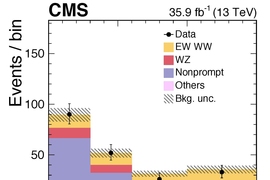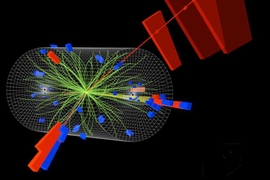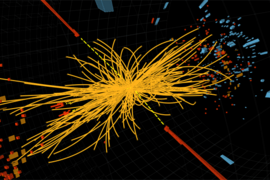This July 4 marks 10 years since the discovery of the Higgs boson, the long-sought particle that imparts mass to all elementary particles. The elusive particle was the last missing piece in the Standard Model of particle physics, which is our most complete model of the universe.
In early summer of 2012, signs of the Higgs particle were detected in the Large Hadron Collider (LHC), the world’s largest particle accelerator, which is operated by CERN, the European Organization for Nuclear Research. The LHC is engineered to smash together billions upon billions of protons for the chance at producing the Higgs boson and other particles that are predicted to have been created in the early universe.
In analyzing the products of countless proton-on-proton collisions, scientists registered a Higgs-like signal in the accelerator’s two independent detectors, ATLAS and CMS (the Compact Muon Solenoid). Specifically, the teams observed signs that a new particle had been created and then decayed to two photons, two Z bosons or two W bosons, and that this new particle was likely the Higgs boson.
The discovery was revealed within the CMS collaboration, including over 3,000 scientists, on June 15, and ATLAS and CMS announced their respective observations to the world on July 4. More than 50 MIT physicists and students contributed to the CMS experiment, including Christoph Paus, professor of physics, who was one of the experiment’s two lead investigators to organize the search for the Higgs boson.
As the LHC prepares to start back up on July 5 with “Run 3,” MIT News spoke with Paus about what physicists have learned about the Higgs particle in the last 10 years, and what they hope to discover with this next deluge of particle data.
Q: Looking back, what do you remember as the key moments leading up to the Higgs boson’s discovery?
A: I remember that by the end of 2011, we had taken a significant amount of data, and there were some first hints that there could be something, but nothing that was conclusive enough. It was clear to everybody that we were entering the critical phase of a potential discovery. We still wanted to improve our searches, and so we decided, which I felt was one of the most important decisions we took, that we had to remove the bias — that is, remove our knowledge about where the signal could appear. Because it’s dangerous as a scientist to say, “I know the solution,” which can influence the result unconsciously. So, we made that decision together in the coordination group and said, we are going to get rid of this bias by doing what people refer to as a “blind” analysis. This allowed the analyzers to focus on the technical aspects, making sure everything was correct without having to worry about being influenced by what they saw.
Then, of course, there had to be the moment where we unblind the data and really look to see, is the Higgs there or not. And about two weeks before the scheduled presentations on July 4 where we eventually announced the discovery, there was a meeting on June 15 to show the analysis with its results to the collaboration. The most significant analysis turned out to be the two-photon analysis. One of my students, Joshua Bendavid PhD ’13, was leading that analysis, and the night before the meeting, only he and another person on the team were allowed to unblind the data. They were working until 2 in the morning, when they finally pushed a button to see what it looks like. And they were the first in CMS to have that moment of seeing that [the Higgs boson] was there. Another student of mine who was working on this analysis, Mingming Yang PhD ’15, presented the results of that search to the Collaboration at CERN that following afternoon. It was a very exciting moment for all of us. The room was hot and filled with electricity.
The scientific process of the discovery was very well-designed and executed, and I think it can serve as a blueprint for how people should do such searches.
Q: What more have scientists learned of the Higgs boson since the particle’s detection?
A: At the time of the discovery, something interesting happened I did not really expect. While we were always talking about the Higgs boson before, we became very careful once we saw that “narrow peak.” How could we be sure that it was the Higgs boson and not something else? It certainly looked like the Higgs boson, but our vision was quite blurry. It could have turned out in the following years that it was not the Higgs boson. But as we now know, with so much more data, everything is completely consistent with what the Higgs boson is predicted to look like, so we became comfortable with calling the narrow resonance not just a Higgs-like particle but rather simply the Higgs boson. And there were a few milestones that made sure this is really the Higgs as we know it.
The initial discovery was based on Higgs bosons decaying to two photons, two Z bosons or two W bosons. That was only a small fraction of decays that the Higgs could undergo. There are many more. The amount of decays of the Higgs boson into a particular set of particles depends critically on their masses. This characteristic feature is essential to confirm that we are really dealing with the Higgs boson.
What we found since then is that the Higgs boson does not only decay to bosons, but also to fermions, which is not obvious because bosons are force carrier particles while fermions are matter particles. The first new decay was the decay to tau leptons, the heavier sibling of the electron. The next step was the observation of the Higgs boson decaying to b quarks, the heaviest quark that the Higgs can decay to. The b quark is the heaviest sibling of the down quark, which is a building block of protons and neutrons and thus all atomic nuclei around us. These two fermions are part of the heaviest generation of fermions in the standard model. Only recently the Higgs boson was observed to decay to muons, the charge lepton of the second and thus lighter generation, at the expected rate. Also, the direct coupling to the heaviest top quark was established, which spans together with the muons four orders of magnitudes in terms of their masses, and the Higgs coupling behaves as expected over this wide range.
Q: As the Large Hadron Collider gears up for its new “Run 3,” what do you hope to discover next?
One very interesting question that Run 3 might give us some first hints on is the self-coupling of the Higgs boson. As the Higgs couples to any massive particle, it can also couple to itself. It is unlikely that there is enough data to make a discovery, but first hints of this coupling would be very exciting to see, and this constitutes a fundamentally different test than what has been done so far.
Another interesting aspect that more data will help to elucidate is the question of whether the Higgs boson might be a portal and decay to invisible particles that could be candidates for explaining the mystery of dark matter in the universe. This is not predicted in our standard model and thus would unveil the Higgs boson as an imposter.
Of course, we want to double down on all the measurements we have made so far and see whether they continue to line up with our expectations.
This is true also for the upcoming major upgrade of the LHC (runs starting in 2029) for what we refer to as the High Luminosity LHC (HL-LHC). Another factor of 10 more events will be accumulated during this program, which for the Higgs boson means we will be able to observe its self-coupling. For the far future, there are plans for a Future Circular Collider, which could ultimately measure the total decay width of the Higgs boson independent of its decay mode, which would be another important and very precise test whether the Higgs boson is an imposter.
As any other good physicist, I hope though that we can find a crack in the armor of the Standard Model, which is so far holding up all too well. There are a number of very important observations, for example the nature of dark matter, that cannot be explained using the Standard Model. All of our future studies, from Run 3 starting on July 5 to the very in the future FCC, will give us access to entirely uncharted territory. New phenomena can pop up, and I like to be optimistic.
